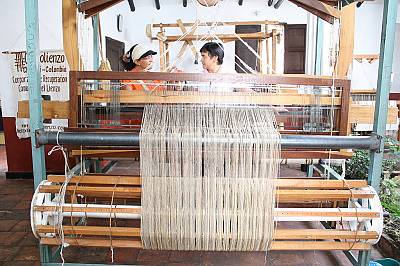- Colombia


The Recovery of Woven Cotton in Charalá, Colombia

© “Tejedora de Corpolienzo en el taller, en la casa del Museo del Algodón y Lienzo de Charala” by Josefino2010 is licensed under CC0 1.0
1. ICH domains
Knowledge and practices concerning nature and the universe, traditional craftsmanship
2. Short description
Charalá forms part of the province of Guanentina, birthplace of Guane indigenous culture, historically known for its artisanal production of handwoven cotton fabrics (lienzo), which is rooted in local mythology originating from ancient pre-Hispanic traditions. In 1986, the local community began a process of recovering this almost extinct textile practice (which fell into decline due to competition from industrial textile production) to update ancient designs and techniques, and to commercialize fabric products to increase awareness of the hand woven fabrics.
To this end, the Corpolienzo (Corporación de Recuperación Comunera del Lienzo - Community Recovery of Woven Cotton Corporation) was established in 1993 by a group of weavers, which created workshop spaces for the production of these textiles, and a museum to showcase the history and importance of this art of weaving to the community. As an associative micro-enterprise, the members of Corpolienzo, mostly women, are committed to producing a handmade and environmentally friendly fabric. Small farmers grow non-transgenic cotton without chemicals, and spinners and weavers strive to respond to market demands. Colombia has had a long history of being in the cotton business, but without the efforts of Corpolienzo, the artisanal work of the spinners and weavers would have been forgotten.
Further information:
For further information on Corpolienzo and traditional knowledge of textile production in Charalá, Colombia (in Spanish):
http://www.cep.org.bo/almanaque/Almanaque_del_Futuro/Almanaque%20del%20Futuro%205.pdf
https://www.youtube.com/watch?v=yejlz7cqpDU
https://www.youtube.com/watch?v=RJlh6LPL_CY
http://corpolienzocharala.blogspot.ca/p/historia.html
https://repository.javeriana.edu.co/handle/10554/14960?mode=simple
3. Link with sustainable development
Reflecting SDG 8, aimed at productive employment and decent work for all, this example shows how intangible cultural heritage can contribute to income generation, not just as a link in a production chain but by designing the production process itself as a cooperative, where everyone is involved and can benefit. Moreover, this traditional craft contributes not only to the continuation of organic cotton production but joins other local initiatives that process and market agro-ecological products such as coffee, or still others that promote sustainable tourism in the protected area of the Andean oak forest, located in the region, as such echoing SDG 12, on ensuring sustainable consumption and production patterns.
4. Questions for reflection
Entering the market poses challenges for this group, as they compete with products made with industrialized cotton yarns, which can be purchased at lower prices. The organic production process, as well as the participation of the spinners in making the fabrics, means that the final price is higher and thus less competitive. Moreover, in the absence of a constant flow of sales and steady earnings, there is a risk that some workers may end up abandoning their jobs and seeking other sources of income. These are some problems that might arise in the commercialization of such products of intangible cultural heritage.
Why is the community wishing to continue transmitting this practice? Does it still carry heritage value for them?
What support could be provided to the community so that they can continue to keep this heritage of theirs alive?